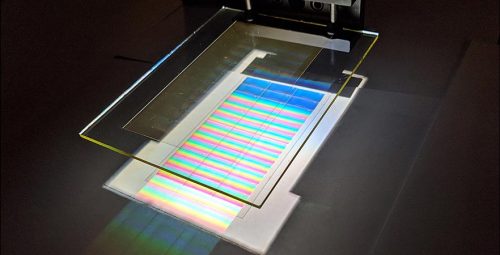A holographic light collector separates the colours of sunlight and directs them to the solar cells.
Researchers at the University of Arizona have developed an innovative technique to capture the unused solar energy that illuminates a solar panel. The study published in the Journal of Photonics for Energy (JPE), elaborates on the special holograms created.

The research was supported by the QESST Engineering Research Center, which is sponsored by the US National Science Foundation and the US Department of Energy to address the challenge of transforming electricity generation to sustainably meet growing demands for energy.
According to the team, the holograms can be easily inserted into the solar panel in which each hologram separates the colours of sunlight and directs them to the solar cells within the solar panel. This method can increase the amount of solar energy converted by the solar panel over the course of a year by about five per cent.
Design
The holographic light collector includes a low-cost holographic optical element along with a diffuser. The optical element is situated symmetrically at the centre of the photovoltaic module to obtain the maximum effective light collection. The system was designed by PhD student Jianbo Zhao, under the supervision of Raymond K. Kostuk, professor of electrical and computer engineering and optical sciences, and in collaboration with fellow PhD student Benjamin Chrysler.

The team presented a reproducible method for evaluating the power collection efficiency of the holographic light collector as a function of the sun angles at different times of day, in different seasons, and at different geographical locations.
According to JPE Editor-in-Chief, Sean Shaheen at the University of Colorado Boulder, the collector and associated method are especially noteworthy because they are low-cost and scalable as well as impactful: “The enhancement of approximately five per cent in annual yield of solar energy enabled by this technique could have a large impact when scaled to even a small fraction of the 100s of gigawatts of photovoltaics being installed globally. Professor Kostuk’s team has demonstrated their holographic approach with a low-cost material based on gelatin, which is readily manufactured in large quantities. And while gelatin is normally derived from animal collagen, progress in lab-derived versions has made it likely that synthetic alternatives could be used at scale.”
This technology is a significant step towards the use of efficient and sustainable energy.
Reference: “Holographic low concentration optical system increasing light collection efficiency of regular solar panels” by Jianbo Zhao, Benjamin Chrysler and Raymond K. Kostuk, 25 May 2021, Journal of Photonics for Energy.






